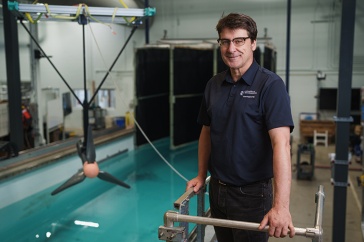
UNH will lead the Cold Climate Center of Excellence for Stormwater Infrastructure Technology, focused on safeguarding water quality. Adobe Stock photo.
UNH has been selected to lead the Cold Climate Center of Excellence for Stormwater Infrastructure Technology, one of four Centers of Excellence for Stormwater Control Infrastructure Technologies established by the U.S. Environmental Protection Agency recently. The Cold Climate Center of Excellence for Stormwater Infrastructure Technology (CCCESIT), co-led with a team at the University of Minnesota, received $1.5 million for research, technical assistance and workforce development aimed at improving stormwater infrastructure and safeguarding water quality.

The Stormwater Center’s field site, located at the edge of a large parking lot on UNH's Durham campus, is a state-of-the-art testing facility where innovative stormwater technologies can be evaluated in a side-by-side comparison as stormwater runs off the adjacent large parking lot. Photo by John Nader.
Stormwater — runoff from rain and snowmelt that flows over impervious surfaces such as paved streets, parking lots and building rooftops and does not soak into the ground — is a significant source of water pollution and a threat to the health of waterways across the country. Managing stormwater runoff presents complex engineering and financial challenges to communities, and harsh winters compound that complexity.
“Cold climates present a special challenge for stormwater management,” says James Houle, director of the UNH Stormwater Center. “Spring snowmelt, freeze-thaw cycles and road salt pose challenges that we in New Hampshire and Minnesota are uniquely positioned to address.”
“Spring snowmelt, freeze-thaw cycles and road salt pose challenges that we in New Hampshire and Minnesota are uniquely positioned to address.”
Drawing on more than 40 years of combined experience at UNH and the University of Minnesota, the CCCESIT will conduct research on new and emerging stormwater control infrastructure technologies, provide technical assistance and develop a workforce that will advance a new, resilient, and more effective stormwater future. The new center’s goals also include increasing the number of communities — especially small, rural, Tribal, underserved and/or disadvantaged communities — that receive information on stormwater technology and financing opportunities for infrastructure projects.
Two initial research projects for the CCCESIT will be research on improvements to biofiltration (rain garden) media to better retain pollutants and research on road salt reduction strategies. CCCESIT’s work will also include technical assistance and education for stormwater researchers in both the public and private sectors as well as the greater community. The center will provide webinars, workshops and training.
In addition to Houle, who will co-lead the project with Andy Erickson at the University of Minnesota, CCCESIT will involve UNH associate professor of civil and environmental engineering Tom Ballestero and Daniel Macadam, research engineer for the UNH Stormwater Center.
The UNH Stormwater Center, founded in 2004, is a dynamic research, testing and educational facility which serves as a technical resource for water managers, planners and design engineers in New England and throughout the United States.
-
Written By:
Beth Potier | UNH Marketing | beth.potier@unh.edu | 2-1566

















































